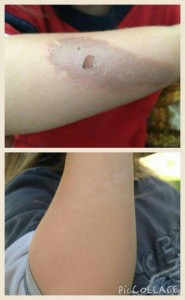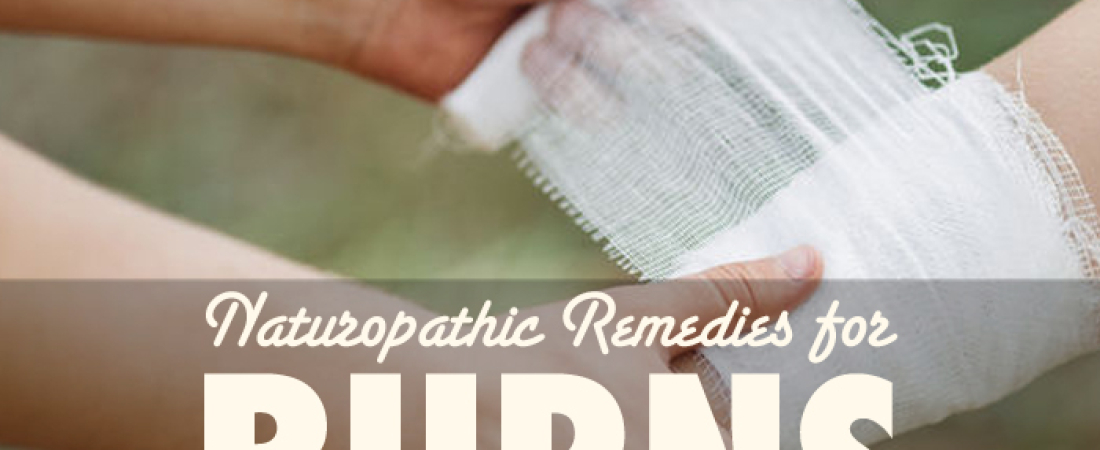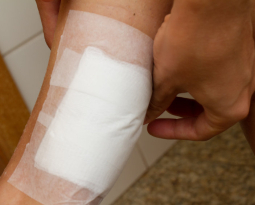Burns can occur when the skin has been damaged as a result of heat (sun, hot liquids), electricity, corrosive chemicals, or radiation (tanning beds, radiation treatments).
The amount of damage that a burn can cause depends upon its location, depth, and the amount of body surface affected. Following is a brief introduction to the classifications of burns:
- First-degree burns affect only the outer layer of the skin (epidermis); causing pain, redness, and a mild amount of swelling. Sunburns often fall into this category.
- Second-degree burns extend deeper into the second layer of skin (dermis). These burns are also painful, with redness and swelling, but additionally will involve blisters.
- Third-degree burns to extend deeper than the second layer of skin. This deep and severe destruction will affect nerves, blood vessels and cells in the area, essentially killing that area of the skin. These burn sites may appears pale, charred, or leathery. Generally there is no pain due to the destruction of the nerve cells.
- Fourth-degree burns extend through the skin and underlying fat into the underlying muscle and bone. Fourth-degree burns are stiff and charred.
Home remedies are often safe, inexpensive, and extremely effective as first aid when applied to first and second-degree burns. With burns of a more severe nature, one should seek emergency care to start and speak with their doctor about possibility of natural care once out of danger.
Top “No-Nos” In Burn Care
-Never use ice on a burn: Too much of a good thing is not a good thing. Running cool water over a burn may help to stop heat and damage from spreading (5-10 minutes is recommended). Ice, however, is too much cold for this situation. You do not want to restrict blood flow, especially for an extended period of time, as this can further damage the tissue.
-Avoid applying any oils (even coconut), burn ointments, butter, petroleum based products, or eggs to a new burn. These will trap the heat and can cause further damage. Once the top layer of the skin (epidermis) has healed, therapeutic ointments and oils can be applied and may reduce scarring.
-Do not pop blisters
Kitchen Remedies
Tea: Tea contains an active constituent called tannins. Tannins are polyphenolic, which are known for their anti-microbial, anti-bacteria and anti-parasitic effects. There have since been some novel compounds with tannins and another constituent called chitosan (synthesized from chitin, found in the exoskeleten of shell-fish). These products come in gels and other patented product forms.1 Additionally, research has supported that tannins positively affect wound healing and decrease scarring. A pilot study conducted in 2005 found that patients who were treated with tannins showed improved eschar formation (initial scab after burn), and less keloid formation following healing, in comparison with several other popular natural treatments.2 How does this translate to your kitchen? You can steep green or black tea, soak your bandage in the tea, and apply soaked bandage directly to a minor to moderate burn. Even easier, tea bags are essentially a beautifully pr- packaged poultice. You can place a steeped tea bag directly on the wound and secure it.
Aloe
Aloe vera is the first remedy that comes to mind for many for burns. This gem contains 75 potentially active constituents: vitamins, enzymes, minerals, sugars, lignin, saponins, salicylic acids and amino acids.3,4,5 Effects appear to range from healing, protecting against skin damage due to radiation, anti-inflammatory actions, moisturizing, to antiseptic properties. There was a nice review of the specific constituents in the Indian Journal of Dermatology in 2008, for further reading pleasure.6 As far as where to find the best sources, I recommend keeping an aloe plant in your home, just for these occasions. If you do not have the plant, make sure to read the label on the gels you buy in the store. Many have very little actual aloe in them, filling that space with lots of other ingredients that you do not want on healthy skin, let alone wounds. These ingredients can include parabens, fragrances, dyes, preservatives, and more.
Potato Peels and Poultices
Who would think to use a potato peel as a dressing for a wound? One large concern for burns that reach 2nd or 3rd degree severity is loss of water. Potato peels are an inexpensive and very effective bandage that prevents evaporation from the skin, keeping moisture in. A dry wound can be very painful and takes longer to heal. Delayed healing time may translate into worsened scarring. A research study comparing treatment with plain gauze and the application of potato peel dressings found that potato peels “permitted the survival of superficial skin cells and hastened epithelial regeneration.”. Basically, this means that the top cells of the skin were more likely to live and it aided healthy cell turnover. This particular study did not find anti-bacterial properties for the peel.7 This being said, the “meat” of a potato does have several key constituents, including tannins, flavinoids (such as Quercitin, which has anti-inflammatory effects), alkaloids; and nutrients such as zinc, vitamin C, choline, B-6 and others that play various roles in the healing process. Traditional applications include slicing potatoes and placing slices directly on affected areas, or make a paste with water and apply as a poultice.8,9
Manuka or Medical Grade Honey
I fully admit that this is my favorite go-to in the kitchen for burns (along with homeopathic remedies), and it is so because I have an additional anecdotal bias. Don’t get me wrong, the body of research supporting medical grade honey is solid without the addition of personal stories. But after watching its almost miraculous effect on my own 3 year old after a horrific fall into a campfire (see before and after pics within article, that’s him!), I now recommend my patients keep medical grade honey patches in their homes, and take them travelling (especially camping). Personal experiences aside, evidence supporting honey’s topical use shows an ability to increase regeneration of blood vessels, connective tissue, and skin cells. Honey also possesses anti-microbial activity.10 If using honey, I highly recommend you buy a medical grade honey (wound dressing, paste or gel) and do not attempt to apply a honey you bought in the store to sweeten your tea and spread on toast. Tests performed by Dr. Bryant at Texas A & M in 2011 found that over 75% of honeys bought in the store were so severely adulterated through ultra-filtering that they no longer resembled the original honey product.11
Other potentially effective kitchen remedies include onion juice (pain, scarring) vinegar (itching and pain), oatmeal (reduce itching), and baking soda (immediately after burn occurs, pain), among others. Onion extract has been the focus of several studies, and there are some over the counter preparations available, such as Mederma® (10% onion extract). A review of the research12 found conflicting evidence with regards to its effectiveness in preventing scarring or improvement with appearance/condition. The other remedies have not been studied in burn care or wound healing, thus their actions and potential effectiveness are poorly understood at this time. Despite this, they continue to be popular home remedies and have amassed personal stories in support of their effectiveness with many recipes to be found on the internet of how to apply in first-aid care of burns.
 Medicine Cabinet
Medicine Cabinet
Homeopathic Remedies
I mentioned these along-side honey as a personal favorite of mine for burns. In chronic care, homeopathic remedies often require extensive intakes by homeopaths or physicians who have been trained in homeopathy. In acute conditions and traumas, such as burns, first-aid homeopathic remedies are often much more straightforward, and can be extremely effective in my clinical experience.
-Urtica Urens (Common Name: Stinging Nettle): Used for first degree burns and minor second degree burns
-Causticum (Common Name: Tinctura acris sine kali): Used for more extensive second degree burns
-Cantharis (Common Name: Spanish Fly): Used for third degree burns
Homeopathy remedies can be found in most health-food stores in the “homeopathics” section. To avoid any confusion, cell salts and flower essences are different than homeopathic remedies. The highest potency most stores are able to carry is 30C (although I would prescribe a 200C acutely for my own patients). Homeopathic remedies come in liquid, pellet, and topical creams/oil, most often. I recommend the pellets to someone who can hold them under their tongue and allow them to dissolve (usually ages 3-5 years and older), and liquid for children or adults who are unable to hold pellets under their tongue. The creams/oils can be applied topically, but work differently; and the same rules apply as the “No-No” section for creams.
Vitamin E
Vitamin E is the main lipid-soluble antioxidant in the skin. Traditionally, it has been used to improve skin appearance and conditions, as well as prevent and reduce scar formation. A study in children found topical vitamin E before and after surgery improved surgical wound healing and cosmetic results. 13 Additionally, new delivery systems are being investigated and may be introduced in the near future. One such delivery system is a Polymeric film that contains vitamin E and aloe for topical application to burn wounds. Biofilms may provide a more calculated and less messy delivery system for these therapies in the future. In the meantime, Vitamin E oils can be purchased in many stores and are typically placed or massaged into the burn, several times daily.
Vitamin C
Vitamin C (ascorbic acid) is involved in all phases of wound healing. After an injury or wound, blood and tissue levels of ascorbic acid will diminish due to the increased need.14 Vitamin C can be taken in food or supplemental form. If you’re going to get Vitamin C from a food source, skip the oranges. Red and green bell peppers, kale, broccoli, papaya, strawberries, cauliflower, brussels sprouts, pineapple, kiwi, and mango all have more vitamin C than the famed orange. To more easily reach the therapeutic level needed for wound care, you may want to include a nutritional supplement of Vitamin C. Divide your dose up throughout the day to maximize your absorption (250-500 mg at a time).
Most of us have burned ourselves at one point or another. If you’re anything like me, it’s pretty much a weekly occurrence. What can I say, I’m clumsy in the kitchen (this is why I keep my doctor gig). First- aid treatment of mild to moderate burns can be extremely effective for pain, healing, and prevention of scars. In the case of severe second or any third/fourth degree burns, urgent attention should be sought and natural remedy management should wait until you are out of danger. Also, keeping a stocked “kitchen medicine cabinet” of first aid remedies can prove itself very handy when those unforeseen accidents sneak up and surprise us. And for those of you that are clumsy like I am, stay safe in this dangerous world.
 Dr. MaryK M. Geyer is a licensed Naturopathic physician, educator, veteran, mother, and committed humanitarian. She earned her doctorate in Naturopathic Medicine from Southwest College of Naturopathic Medicine, where she focused her training on working with underserved populations. Prior to medical school, she graduated with Honors from the State University of New York at New Paltz with a Bachelor of Science degree in Organismal/Environmental Biology. She completed a post-graduate preceptorship focused in obstetrics and pediatrics with Dr. Farra Swan, ND before undergoing her family practice residency at Southwest Naturopathic Medical Center.
Dr. MaryK M. Geyer is a licensed Naturopathic physician, educator, veteran, mother, and committed humanitarian. She earned her doctorate in Naturopathic Medicine from Southwest College of Naturopathic Medicine, where she focused her training on working with underserved populations. Prior to medical school, she graduated with Honors from the State University of New York at New Paltz with a Bachelor of Science degree in Organismal/Environmental Biology. She completed a post-graduate preceptorship focused in obstetrics and pediatrics with Dr. Farra Swan, ND before undergoing her family practice residency at Southwest Naturopathic Medical Center.
Dr. Geyer has received additional training in Women’s Medicine, Pediatrics, Dermatology, Minor Surgery, and Evidence Based Medicine. Dr. Geyer previously served as the Associate Dean of Naturopathic Medicine and Residency Director at National College of Natural Medicine and was a co-founder and previous Executive Direct of Naturopaths Without Borders, leading over 20 international medical trips to Mexico and Haiti. She has over 15 years of teaching experience, including teaching dermatology and minor surgery at two of the accredited Naturopathic Medical schools, and continues to lecture and write for the public and other health professionals. Dr. Geyer currently provides comprehensive primary care, including naturopathic dermatology, to her patients at Southwest Naturopathic Medical Center in Tempe, Arizona.
References:
- Sevgi M, Toklu A, Vecchio D, Hamblin MR. Topical Antimicrobials for Burn Infections – An Update. Recent patents on anti-infective drug discovery. 2013;8(3):161-197.
- Chokotho L, Van Hasselt E. The Use of Tannins in the Local Treatment of Wounds- A pilot study. Malawi Medical Journal. 2005; 17(1): 19-20.
- Atherton P. Aloe vera revisited: a Review of Aloe Vera Gel. Br J Phytother. 1998;4:76–83
- Shelton M. Aloe Vera, ITS Chemical and Therapeutic Properties. Int J Dermatol. 1991;30:679–83.
- Atherton P. The essential Aloe vera: The actions and the evidence. 2nd ed 1997
- Surjushe A, Vasani R, Saple DG. ALOE VERA: A SHORT REVIEW. Indian Journal of Dermatology. 2008;53(4):163-166. doi:10.4103/0019-5154.44785.
- Keswani MH, Vartak AM, Patil A, Davies JW. Histological and bacteriological studies of burn wounds treated with boiled potato peel dressings. Burns. 1990;16:137–143
- Umadevi M., Sampath Kumar P.K., Bhowmik D., Duraivel S.. Health Benefits and Cons of Salnum Tuberosum, Journal of Medicinal Plants studies, 2013; 1 (2): 16-25
- Ware M., What are the Health Benefits of Potatoes? Medical News Today Web Site. http://www.medicalnewstoday.com/articles/280579.php. Published August 30, 2014. Accessed August 15, 2015.
- Dunford C et al. The Use of Honey in Wound Management. Nursing Standard, 2000; 15, 11, 63-68
- Schneider A., Tests Show Most Store Honey Isn’t Honey; Ultra-Filtering Removes Pollen, Hides Honey Origins. http://www.foodsafetynews.com/2011/11/tests-show-most-store-honey-isnt-honey . Published November 7, 2011. Accessed August 17, 2015.
- Sidgwick GP, McGeorge D, Bayat A. A comprehensive evidence-based review on the role of topicals and dressings in the management of skin scarring. Archives of Dermatological Research. 2015;307(6):461-477. doi:10.1007/s00403-015-1572-0.
- Zampieri N., Zuin V., Burro R., et al.. A Prospective Study in children: Pre- and Post-Surgery use of Vitamin E in Surgical Incisions. J Plas Reconstr Aesthet Surg. 2010 Step; 63 (9): 1474-8.
- Moores j. Vitamin C: A Wound Healing Perspective. British Journal of Community Nursing. 2013 Dec; Suppl S6-11.















